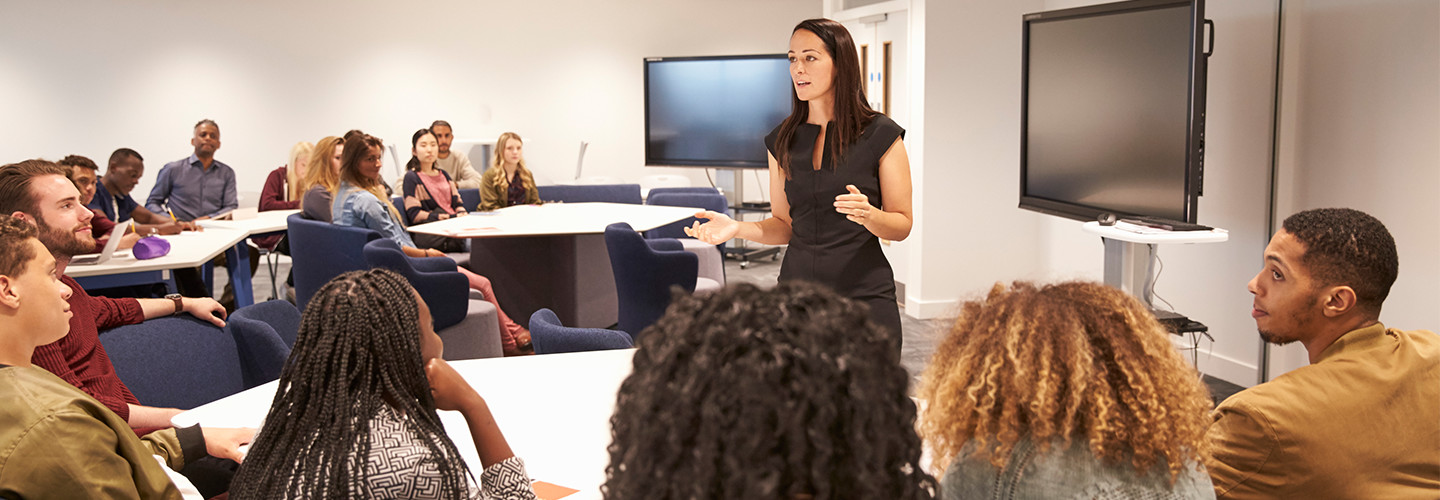Interactive Tech Transforms the College Learning Experience
Collaborative, project-based learning is central to K–12 education, and it’s gaining traction in higher education in the form of active-learning classrooms too.
Institutions such as the University of Maryland and the University of California, Irvine are investing in campus spaces that put collaboration and flexibility at the forefront of learning.
One reason for the shift is that active-learning classrooms are starting to prove their popularity — and pedagogical effectiveness — in K–12 spaces. Another reason is the availability of wireless solutions that make it nearly seamless for educators and students to connect, share and collaborate.
From a pedagogical perspective, instructors are moving away from being tied to the front of the classroom. Wireless solutions give them the ability to be mobile, to interact with students and to wirelessly screen-share their devices to a projector or a panel from anywhere in the classroom. It’s a reimagining of what the classroom looks like, and it starts with connectivity.
MORE FROM EDTECH: Check out how universities can bring modern learning environments to campus!
Classroom Solutions Are Easy to Manage and Easy to Use
In the past, in the hopes of making classroom technology use easier for instructors, many colleges invested in in-room control systems. The downside of these tools is they often require a big back-end lift from IT, and making changes can be expensive and time-consuming. Now, IT and educators ask: Is there a way to use technology in the classroom that’s really simple for users?
The answer, for institutions like California State University, Stanislaus is the wireless collaboration system. Essentially, it’s an enterprise version of the hardware many individuals have at home, such as an Apple TV or a Google Chromecast; plug it in and stream content from a laptop or phone to the television. These solutions work much the same way in the classroom.
Instead of back-end programming, instructors now use the wireless network to achieve those connections. Both students and faculty can screen-share content by casting to a large projector in the front of the room or to multiple displays in pods or huddle areas.
The systems CDW recommends are compatible with any operating system. That’s great for instructors and students, because they’re already familiar with the platform. If an instructor has an Apple device, they already know how to use AirPlay, and the same goes for Windows and Chrome.
Users don’t have to learn anything new in order to connect. That’s important, because classroom solutions need to integrate seamlessly and be user-friendly. From an IT perspective, they’re easy to manage over the network and scale well to large deployments.
Educators also are rethinking physical design, moving toward spaces that facilitate group work and increase flexibility. A single classroom may be used by one instructor who wants to engage students in a pod arrangement and by another who prefers a traditional lecture layout. Modular classrooms, similar to those popular in K–12, give instructors more options without requiring more space.
Bring Campus Stakeholders Together to Ensure the Best Outcomes
When colleges embark on the journey to modernize classrooms, the process itself should be collaborative. We often see one champion who’s eager to bring everyone else in this new direction, but to do that effectively, it’s important to involve all the stakeholders from the beginning. The conversation should include faculty members, instructional experts and IT.
They all have valuable input to offer to ensure the technology ultimately adopted can support the desired teaching and learning that will take place in the room.
Often, that’s where CDW comes in. CDW wants to make sure the system is easy for IT to manage and scale, but it also needs to support educational goals and deliver a positive user experience. To achieve that, CDW’s educational strategists will bring all the stakeholders to the table to identify their goals. It’s a step that needs to happen to make sure there’s a unified vision for this classroom, and then that vision can become a reality.
This article is part of EdTech: Focus on Higher Education’s UniversITy blog series.









